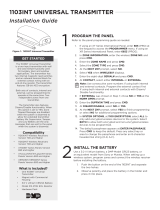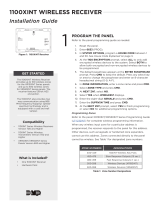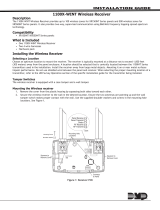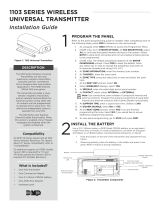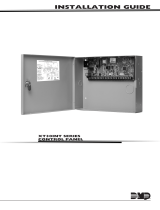Page is loading ...

1106-WINT WIRELESS UNIVERSAL
TRANSMITTER
Installation Guide
The 1106-WINT Wireless Universal
Transmitter is a wireless, two-input
transmitter typically used for door
and window applications.
The 1106-WINT provides a cover
tamper, magnetic reed switch, and
an on-board terminal block to allow
for external contact wiring.
Both sets of contacts, internal and
external, can be programmed to
operate at the same time. This
allows two independent zones to
operate from a single 1106-WINT.
The 1106-WINT also features
Disarm/Disable functionality. When
this option is set to YES, Zone
Tripped messages are disabled
when the system is disarmed to
allow for extended transmitter
battery life. Supervision, Tamper,
and Low Battery are the only
messages that are sent to the panel
when the system is disarmed.
Compatibility
XT30INT Series Panels,
XR150INT/XR550INT Series Panels,
and all DMP International Wireless
Receivers
What is Included?
• One 1106-WINT Wireless Universal
Transmitter in a two-part housing
• One magnet in a one or two-part
housing
• One 3.0V lithium CR123A battery
• Hardware pack
• Double-sided tape
1
PROGRAM THE PANEL
Refer to the panel programming guide as needed.
1. In ZONE INFORMATION, enter the wireless ZONE NO:.
2. Enter the ZONE NAME.
3. Select the ZONE TYPE.
4. At the NEXT ZN? prompt, select NO.
5. Select YES when WIRELESS? displays.
6. Enter the eight-digit SERIAL#.
7. At CONTACT, select either INTERNAL or EXTERNAL.
Note: Use consecutive zone numbers if using both internal
and external contacts.
8. If EXTERNAL was chosen in Step 7, choose NO or YES at
the NORM OPEN prompt.
9. Enter the SUPRVSN TIME.
10. At DISARM DISABLE, select NO or YES.
11. At the NEXT ZN? prompt, select NO to finish programming
or select YES for additional programming options.
2
Figure 1: 1106-WINT Wireless
Universal Transmitter
INSTALL THE BATTERY
Use a 3.0V Lithium battery, a DMP Model CR123A battery, or an
equivalent model from Sony or Murata. Keep in mind, when setting
up a wireless system, program zones and connect the wireless
receiver before installing the battery.
1. Open the 1106-WINT by inserting a 1/4” flat head
screwdriver in the tab. See Figure 1.
2. Gently pull upwards on the screwdriver handle until the
housing completely opens.
3. Observe polarity and place the battery in the holder and
press it into place.
3
The 1106-WINT provides an LED Survey operation to allow one
person to confirm communication with the wireless receiver or
panel while the cover is removed. If installating more than one
1106-WINT at a time, use one 1106-WINT to check all locations.
1. With the cover removed, hold the 1106-WINT in the exact
desired location.
2. Press the tamper switch to send data to the panel and
determine if communication is confirmed or faulty.
Confirmed: If communication is confirmed, for each
press or release of the tamper switch the LED blinks
immediately on and immediately o.
Faulty: If communication is faulty, the LED remains
on for approximately 8 seconds or flashes multiple
times in quick succession. Relocate the 1106-WINT
or wireless receiver until the LED confirms clear
communication.
SELECT A LOCATION
Tab
DESCRIPTION

2 1106-WINT INSTALLATION GUIDE | DIGITAL MONITORING PRODUCTS
MOUNT THE 1106-WINT
Mount the Transmitter
1. If mounting with screws, remove the battery. If mounting
with double-sided tape, place the tape on the back of the
transmitter.
2. Hold the transmitter in place with the magnetic reed switch
closest to where the magnet will be mounted. See Figure 2.
Ensure the transmitter and the magnet will be no more than
1.3cm (0.5in) apart.
3. If using screws, place the supplied #4 screws into the two
mounting holes and secure the transmitter to the surface. If
using double-sided tape, place the transmitter on the surface.
4. Snap the transmitter cover back onto the base.
Mount the Magnet
Standard Installation
1. Push the supplied magnet into the magnet cover.
2. Hold the magnet base on the door closest to the
magnetic reed switch, no more than 1.3cm (0.5in) from the
transmitter.
3. If using screws, use the provided #4 screws to mount the
base. See Figure 3. If using double-sided tape, place the
tape on the back of the base and place on the surface.
4. Snap the cover onto the base.
Commercial Installation
1. Push the supplied magnet into the magnet cover.
2. Place and hold the magnet cover directly on the door
closest to the magnetic reed switch, no more than 1.3cm
(0.5in) apart from the transmitter.
3. Use the provided #4 screws to mount the cover.
See Figure 4.
4
5
TEST THE 1106-WINT
After installing the 1106-WINT, perform a Walk Test to confirm the 1106-WINT is communicating with the
panel. At the keypad, enter 8144 then CMD for XR150INT/XR550INT Series panels or 814 then CMD for
XT30INT Series panels. Sselect WLS. If the 1106-WINT fails to check in at the keypad, relocate the wireless
device, receiver, or panel.
Figure 3: Standard Installation
Figure 4: Commercial Installation
Wall Mount
Screw Holes
Magnetic Reed
Switch
Figure 2: Transmitter Components

1106-WINT INSTALLATION GUIDE | DIGITAL MONITORING PRODUCTS 3
Connect External Contacts
Refer to Contacts in Zone Information within the appropriate panel programming guide for additional
information. DMP recommends using 18 or 22-gauge unshielded wire.
1. Remove the cover of the 1106-WINT.
2. Use a flat head screwdriver to loosen the two screws on the 1106-WINT terminal block. See Figure 5.
3. Insert the external contact wiring into the 1106-WINT terminal block and tighten the screws.
4. Depending on how the contact was programmed in the Program the Panel section, connect the
other ends of the wires to the external contact as either normally open (N/O) or normally closed
(N/C) without an end-of-line resistor.
Figure 5: Connect External Contact
MODEL 1106
CR123
External Contact
Terminal Block
1106
Door
Window
External
Contact
ADDITIONAL INFORMATION
1. Open the transmitter housing to expose the inside of the 1106-WINT. See Figure 1.
2. Remove the old battery, observe polarity, and place the new battery in the holder.
3. Snap the cover back on the 1106-WINT.
Replace the Battery
Once the battery is replaced, a sensor reset is required at the keypad to clear the LOBAT message.
1. On an LCD keypad, press and hold 2 for two seconds. On a Graphic Touchscreen Keypad,
press RESET.
2. Enter your user code, if required. The keypad displays SENSORS OFF followed by SENSORS
ON.
Sensor Reset to Clear LOBAT
Magnet
Program one
zone as an
internal contact.
Program the next
consecutive zone as
an internal contact.

Designed, engineered,
and manufactured in
Springfield, Missouri using U.S.
and global components.
LT-1377INT 18095
INTRUSION • FIRE • ACCESS • NETWORKS
2500 North Partnership Boulevard
Springfield, Missouri 65803-8877
866.266.2826 | DMP.com
Patents
U. S. Patent No. 7,239,236
Compatability
1100XINT Wireless Receiver
1100DINT Wireless Receiver
XT30INT Series Panels
XR150INT/XR550INT Series Panels
International Certifications
EN 50130-4:2011+A1:2014 Alarm systems. Electromagnetic
compatibility. Product family standard:
Immunity requirements for components
of fire, intruder, hold up, CCTV, access
control and social alarm systems.
EN 61000-6-3:2007 Electromagnetic compatibility (EMC).
Generic standards. Emission standard
for residential, commercial and light-
industrial environments.
1106-WINT Wireless
Universal Transmitter
Specifications
Battery
Life Expectancy 5 years (normal
operation)
Type 3.0V lithium CR123A
Frequency Range 863-869MHz
Color White
Housing Material Flame retardant ABS
Dimensions
Transmitter Case (1.79”L x 1.69”W x 0.84”H)
4.5L x 4.3W x 2.1H cm
Standard
Mag. Housing (
1.35”L x 0.38”W x 0.43”H)
3.4L x 1W x 1.1H cm
Comm. Mag. Housing (2.25”L x 0.38”W x 0.34”H)
5.7L x 1W x 0.9H cm
/
